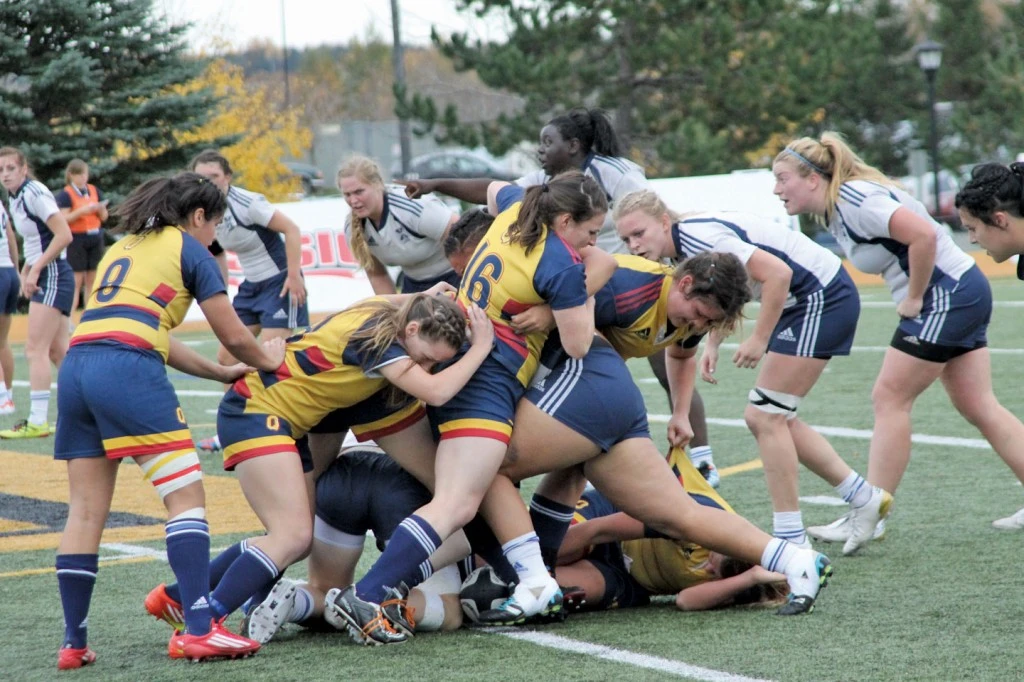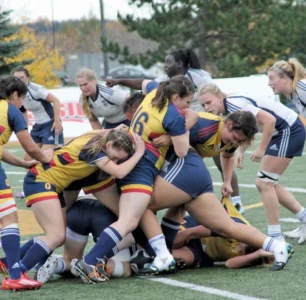The breakdown in rugby is a critical phase where possession is contested after a tackle. It requires players to compete for the ball either by securing possession or disrupting the opposition’s possession.
Explore the intricacies of the breakdown in women’s rugby, including techniques for securing possession and disrupting the opponent’s play, crucial for success on the field.
Breakdown FAQ
Breakdown Strategy
- What is the role of the first arriving player at the breakdown?
The first arriving player at the breakdown, often the ball carrier or a supporting player, has a vital role in securing possession or ensuring quick ball for their team. Their primary objective is to secure the ball by either presenting it cleanly for their teammates or placing it back on their side of the ruck. Timing, body position, and awareness of opposing players are crucial in fulfilling this role effectively.
- What is the role of the "jackaler" at the breakdown?
The “jackaler,” typically a skilled openside flanker, plays a crucial role at the breakdown. Their primary task is to compete for the ball after a tackle, aiming to secure a turnover or slow down the opposition’s possession. This requires quick reflexes, strength, and excellent body positioning to contest for the ball legally and effectively.
- How is the breakdown (ruck) area defended effectively?
The breakdown is defended effectively through a combination of techniques. Players must stay on their feet, maintain a low body position, and enter the breakdown with proper technique to secure possession or disrupt the opposition’s attack. Communication, quick decision-making, and physicality are key elements in defending the breakdown successfully.
Breakdown Rules
- Who can participate in the breakdown?
Any player from both teams can participate in the breakdown, either to contest possession or support teammates. However, players must adhere to the laws of the game regarding entry, offside lines, and legal contesting of the ball to ensure fair competition and player safety. Understanding roles and responsibilities in the breakdown is crucial for all players to contribute effectively to their team’s success.
- When does a breakdown end?
A breakdown ends when the ball emerges from the ruck or is deemed unplayable by the referee. At this point, the referee will signal the end of the breakdown, allowing play to continue with a scrum, lineout, or other appropriate restart. It’s essential for players to recognize the conclusion of the breakdown and adjust their positioning and tactics accordingly to maintain a competitive advantage.
- When does a breakdown become a "messy" or "unplayable" ruck?
A breakdown becomes a “messy” or “unplayable” ruck when the ball is obscured or trapped, making it impossible for players to contest possession legally. This often occurs due to players not releasing the ball, collapsing the ruck, or other infringements that impede fair competition. When the ruck becomes unplayable, the referee may stop play and award a scrum to restart the game.
- What happens if the ball becomes trapped in the breakdown and doesn't come out?
If the ball becomes trapped in the breakdown and doesn’t emerge, the referee may award a scrum to restart play. This decision is typically made if the ball is deemed unplayable or if neither team can secure possession legally. Scrum resets provide both teams with an opportunity to contest possession and continue the flow of the game.
- What are the responsibilities of the referee and the assistant referees at the breakdown?
The referee and assistant referees at the breakdown are responsible for ensuring that players adhere to the laws of the game, maintain fairness, and ensure player safety. They must accurately judge infractions, such as offside, illegal entry, or foul play, and enforce penalties accordingly. Additionally, they play a crucial role in managing the tempo of the game and ensuring that the breakdown is contested fairly by both teams.
- Is the player with the ball in the breakdown allowed to fend off opponents?
Yes, the player with the ball in the breakdown is allowed to fend off opponents within the laws of the game. Fending off opponents using the arm or hand is a legitimate tactic to maintain possession or create space. However, care must be taken to avoid high tackles or dangerous play, which could result in penalties or disciplinary action from the referee.
- Is the offside line in the breakdown the same as the gain line?
No, the offside line in the breakdown and the gain line are distinct concepts in rugby. The offside line in the breakdown is formed when the breakdown occurs, delineating where players must be positioned to maintain an onside position. The gain line, on the other hand, refers to the point on the field where the attacking team gains or loses ground relative to their starting position. Both lines are crucial in determining player positions and influencing tactical decisions during a match.
- How is the breakdown formed during a rugby match?
The breakdown is formed when a tackle occurs during a rugby match, and one or more players from each team come into contact over the tackled player and compete for possession of the ball. It is a crucial phase of play where teams contest for possession and attempt to gain territory or score points. Proper technique, timing, and adherence to the laws of the game are essential in navigating the breakdown effectively.
- Can a player who is not on their feet play the ball in the breakdown?
No, players must be on their feet to legally play the ball in the breakdown. Playing the ball while off their feet is considered a penalty offense, often resulting in sanctions from the referee and potential turnovers in possession. Maintaining proper body position and adhering to the laws of the game are essential for players participating in the breakdown.
- Can a player join the breakdown from any direction?
Yes, players are allowed to join the breakdown from any direction as long as they do so legally and do not infringe upon the laws of the game. However, entering the breakdown from the side or in an offside position can result in penalties, so players must approach the breakdown with awareness and adhere to proper techniques.
- Can a player join the breakdown after a tackle has been completed?
Yes, players can join the breakdown after a tackle has been completed to compete for possession or support their teammates. Timing and technique are crucial to ensure legality and effectiveness in securing the ball or disrupting the opposition’s play.
- Are players allowed to use their hands when competing for the ball in the breakdown?
No, players are not allowed to use their hands when competing for the ball in the breakdown. The use of hands in the breakdown is considered a penalty offense, often resulting in a turnover or a penalty awarded to the opposing team. Players must contest the ball legally, using their feet or maintaining a strong body position to secure possession.
- Are players allowed to use their feet to play the ball in the breakdown?
Yes, players can use their feet to play the ball in the breakdown, commonly known as “rucking,” as long as they do not endanger opponents. Proper technique and adherence to the laws of the game are essential to avoid penalties and maintain player safety.
- Are players allowed to dive or dive over the breakdown to reach the ball?
Yes, players are permitted to dive or dive over the breakdown to reach the ball as long as they do so within the laws of the game, maintaining fairness and safety. However, reckless or dangerous actions could result in penalties or sanctions from the referee.
Breakdown
- What is the difference between a ruck and a maul?
While both involve players contesting for possession of the ball, the key difference between a ruck and a maul lies in how the ball carrier is held. In a ruck, the ball is on the ground and must be played with the foot, while in a maul, the ball carrier is held up off the ground by one or more players from each team, allowing for more dynamic movement and potential advancement towards the try line.
- What is the breakdown in rugby?
The breakdown in rugby is a contested phase of play that occurs after a tackle. It involves players from both teams competing for possession of the ball on the ground. The breakdown is a dynamic and fluid situation where players use various techniques to secure or steal the ball, such as rucking, counter rucking, and clearing out opponents. It’s a crucial aspect of the game’s flow and strategy.
- What is the "gate" in the breakdown?
The “gate” in the breakdown refers to the legal entry point for players to join the breakdown area after a tackle. Players must approach the breakdown from behind the hindmost foot of the teammate or opponent closest to them. This ensures fair contesting for the ball and prevents illegal entry, such as coming in from the side or sealing off the breakdown.
- What is counter rucking?
Counter rucking is a defensive technique in rugby where players from the defending team aggressively compete for possession at the breakdown. Instead of allowing the attacking team to secure the ball, defenders aim to disrupt the breakdown by driving over it, pushing attackers off the ball, and regaining possession for their team. It’s a crucial aspect of defensive play in rugby.
- What is a turnover?
A turnover in rugby refers to the transition of possession from one team to the other during active play. It typically occurs when the team in possession loses control of the ball, either through a mistake, infringement, or successful defensive action by the opposing team. Turnovers are pivotal moments in the game, often leading to rapid changes in momentum and scoring opportunities.
- What does Turnover mean?
A turnover in rugby happens when possession of the ball changes hands during open play. It occurs when the team in possession loses the ball to the opposition, either through a mistake, penalty, or successful defensive play. Turnovers can significantly impact the flow and outcome of the game, often leading to sudden shifts in momentum and scoring opportunities.
- What does Ruck mean?
A ruck occurs when one or more players from each team, who are on their feet, are in physical contact, close around the ball on the ground. It’s formed after a tackle, and players must bind onto each other to maintain the ruck. The ruck is a key element of rugby, determining possession and providing opportunities for both attacking and defensive play.
- What does Cleanout mean?
Cleanout is a technique used in rugby to remove opposing players from the breakdown area. Players involved in the cleanout aim to clear defenders away from the ball, creating space and securing possession for their team. It’s a crucial aspect of maintaining continuity and momentum in attack or disrupting the opposition’s defensive structure.
- What does Breakdown mean?
In rugby, the breakdown refers to the moment when a tackle is made and players from both teams converge over the ball, attempting to secure possession. It’s a pivotal phase where players contest for the ball on the ground, either by trying to retain it (for the attacking team) or steal it (for the defending team).
- What constitutes a "sealed" or "sealed off" breakdown situation?
A “sealed” or “sealed off” breakdown occurs when players effectively prevent the opposition from contesting for the ball legally. This can happen when players fail to maintain their position on their feet or obstruct the opposition’s access to the ball, leading to penalties or turnovers. It’s important for players to adhere to the laws of the game to ensure fair play.

